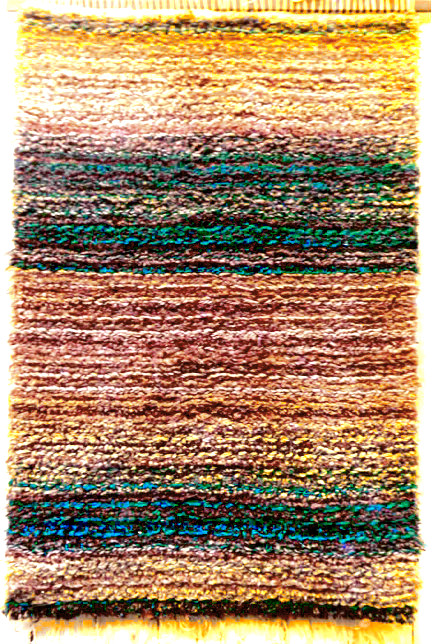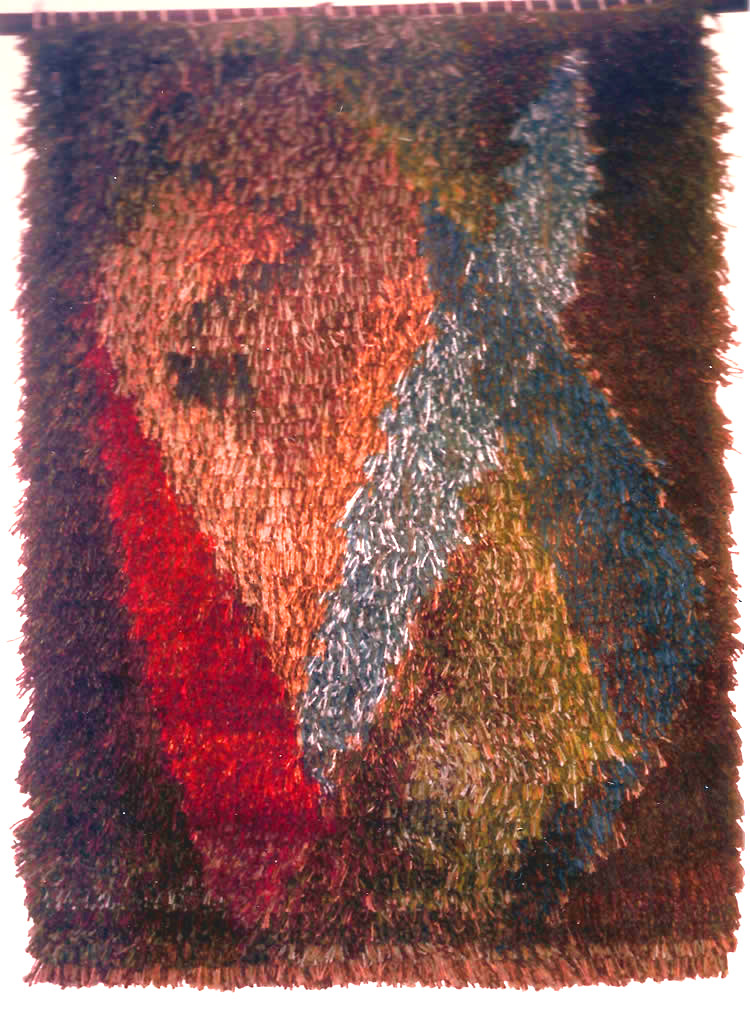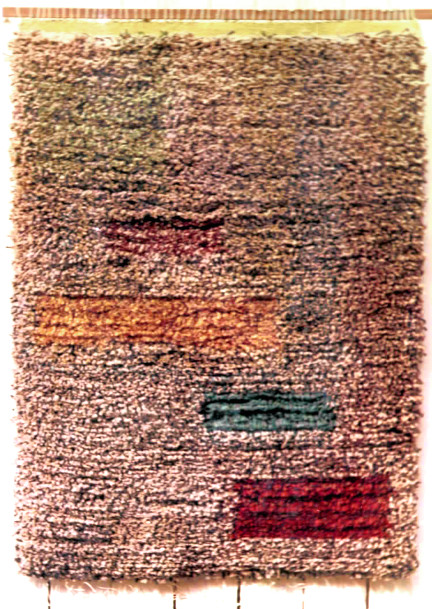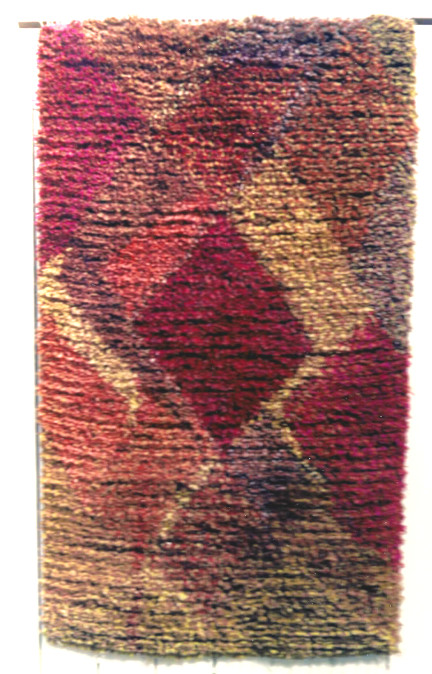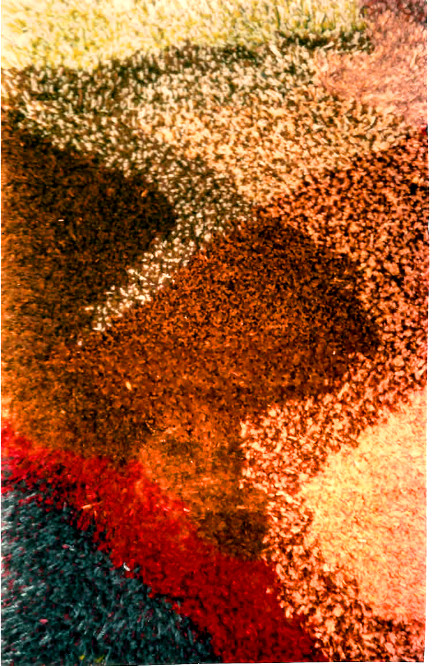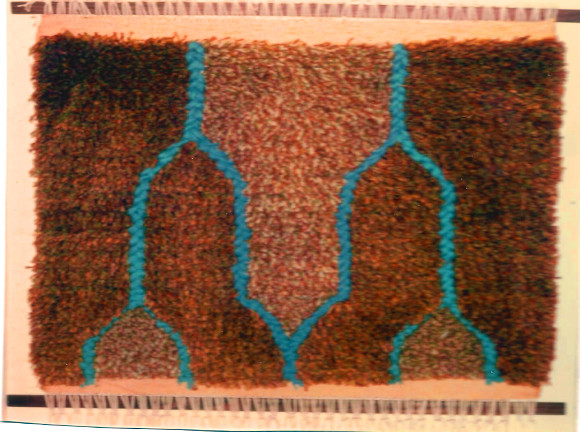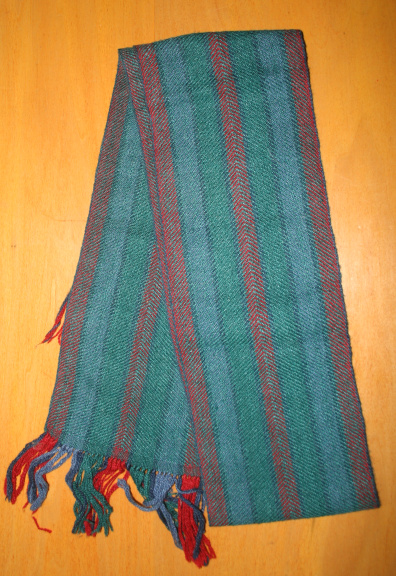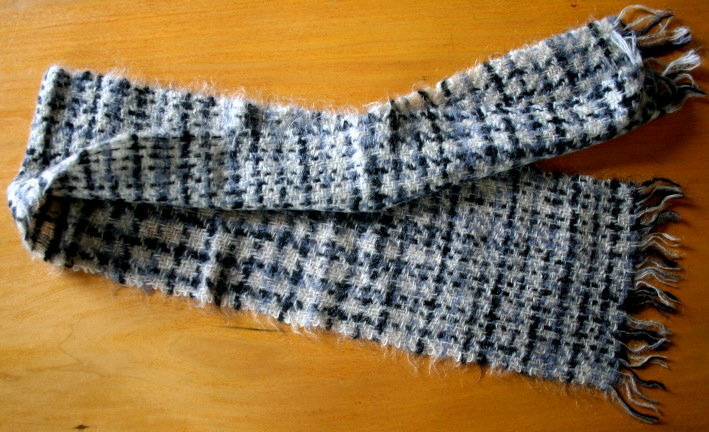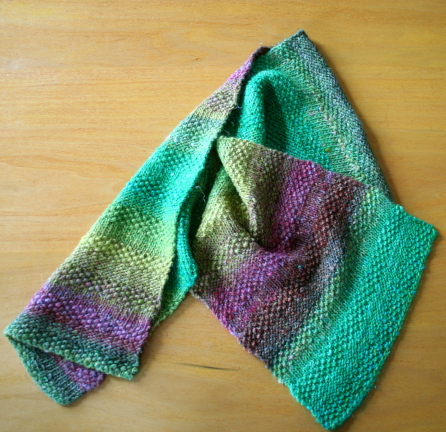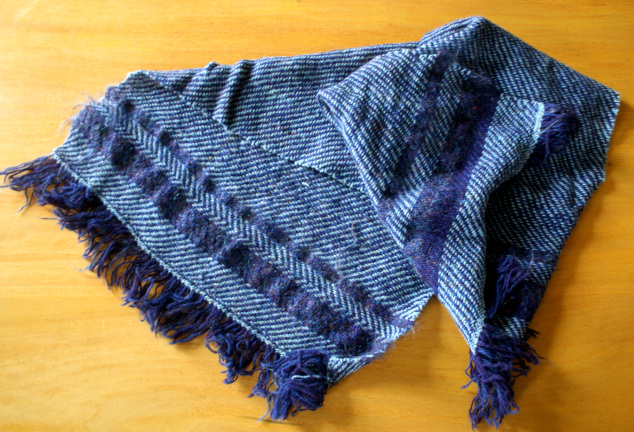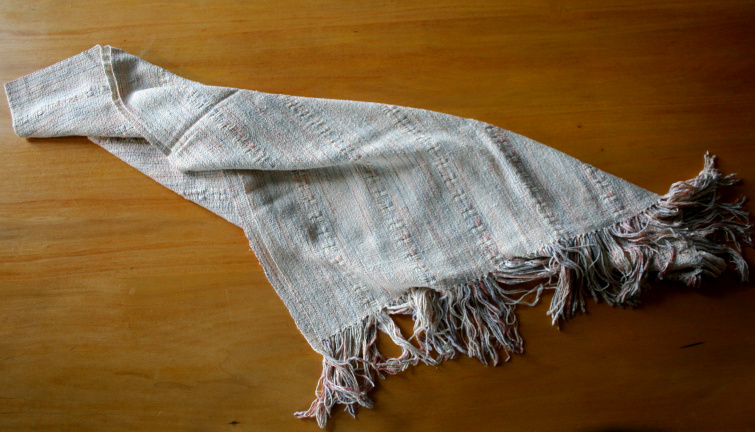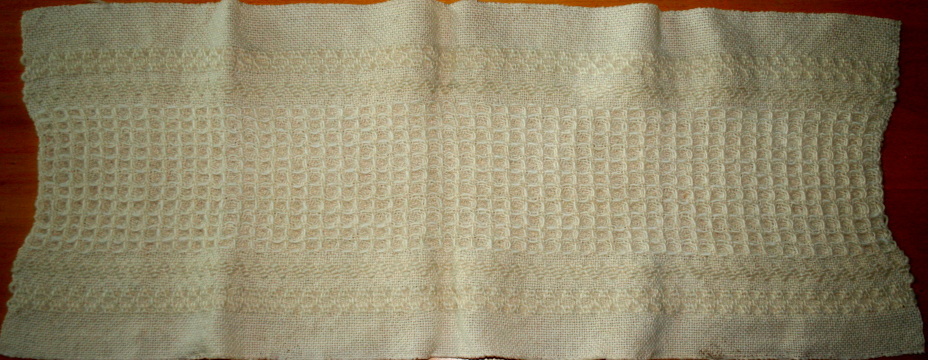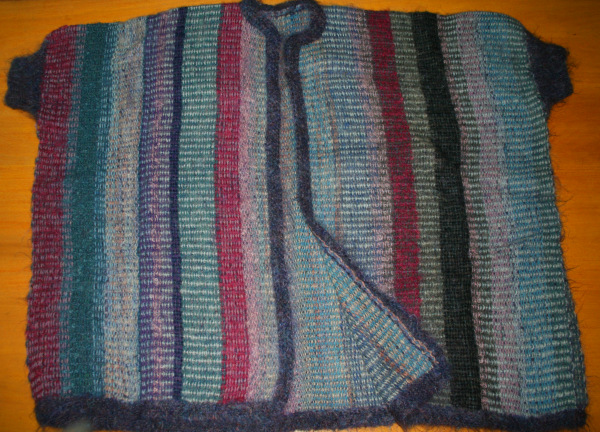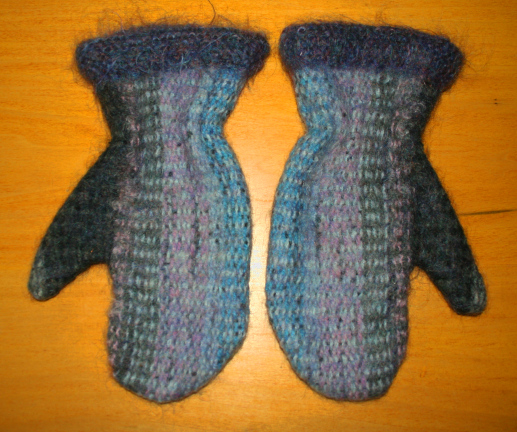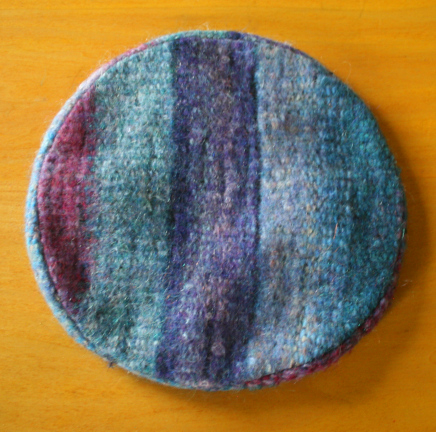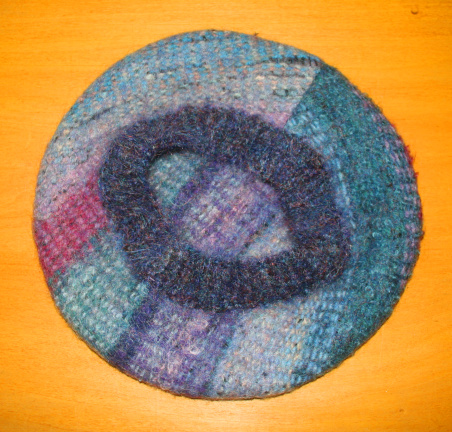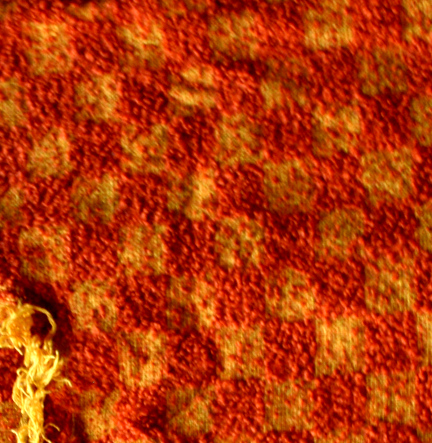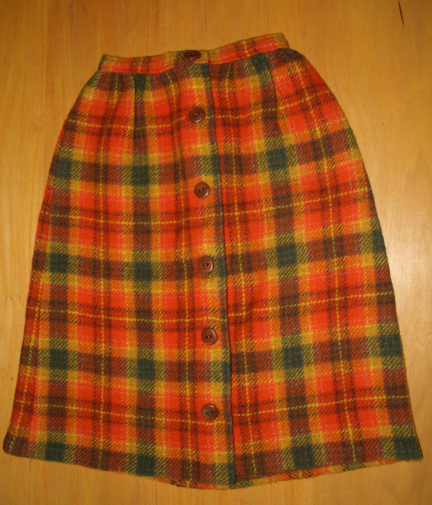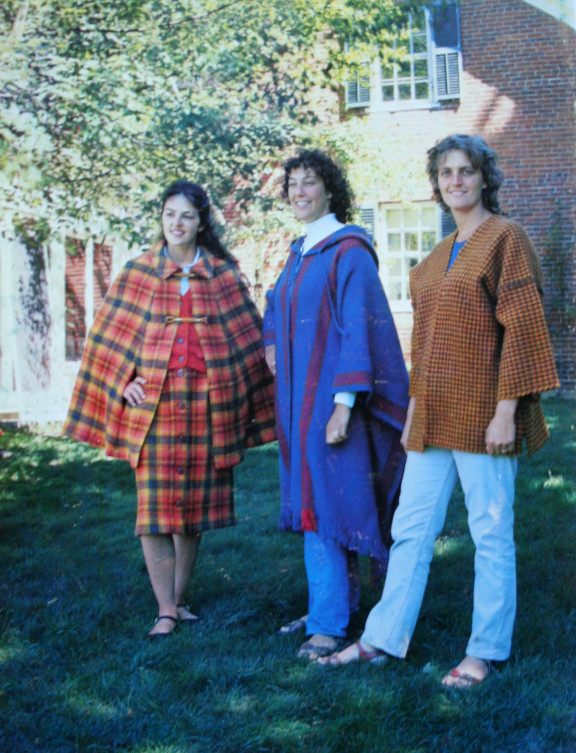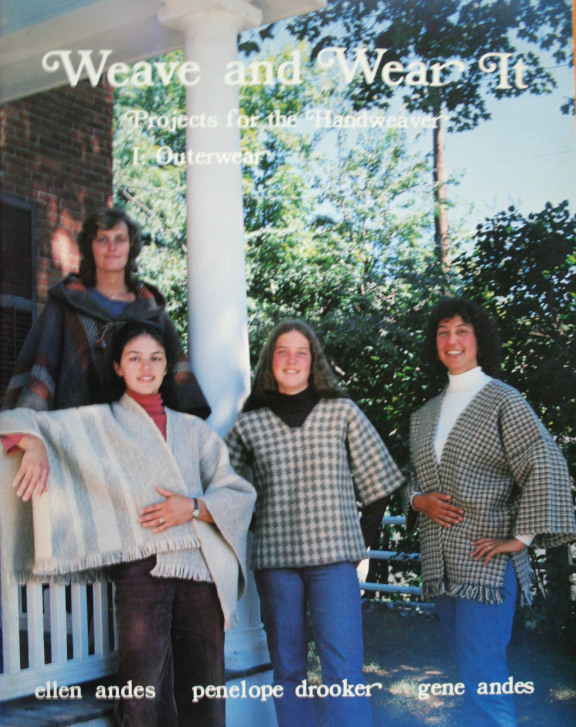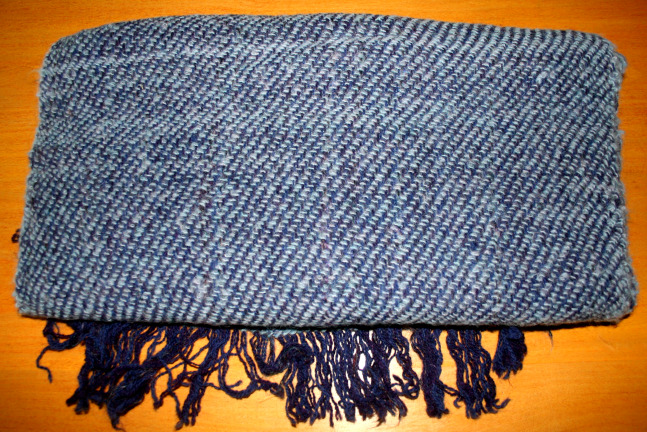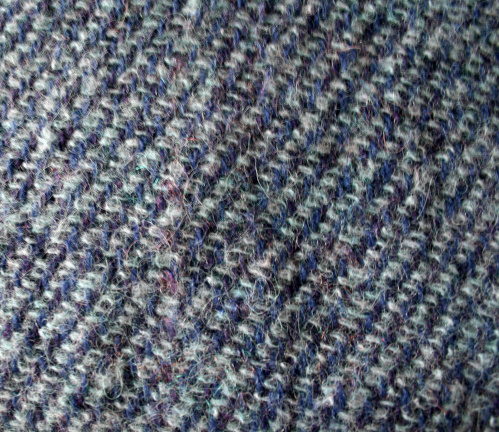When we first married, we each had hobbies and interests that we brought with us.
But soon, we consciously decided to find activities that we could do together or at least
in proximity, sort of like the "parallel play" stage of toddler socialization. We also made
sure to maintain our common interests, such as a love of music.
As part of the process of finding activities we could do collaboratively, Ellen settled on learning to weave
and Gene decided to pursue woodworking. After finishing school and relocating to New Orleans, we soon
acquired our first loom, an old 4 harness counterbalanced loom, that we kept for decades. After
some months in New Orleans, an artist friend approached us about sharing a small shotgun house
she was using as a studio. We soon moved the weaving and Gene's fledgling wood working activities
into the back of the house. When our friend moved on to a better studio, we
we rented the whole house to use as a studio, and expanded the wood working into
the front part of the place, a former neighborhood store. And expanded the weaving related equipment and
supplies, too. We kept that little house/studio until we left New Orleans a couple of years later.
Here are some pictures of that first loom set up in that first studio. The loom had a sectional
warp and came with a warping stand, so it was particularly good for doing the rugs that were the
first projects.
In the samples shown below, the first shows a rug
with both cut and uncut pile rows. The rest are with cut pile, except the last which
shows the cut pile combined with a pattern of chained uncut pile weft yarn. All
the rugs shown were about 36 inches wide and varied from four to seven feet in length.
Because the yarn used was commercial rug yarn, it was permanently moth-proofed and
many of the rugs traveled with us until our next-to-last down-size, when all but one
were given away.
Perhaps the best thing about our little studio house was that
directly across the street, in another former neighborhood store, a
butcher shop, a sculptor, Mike Price, had his studio. Because he and we
all kept late hours, we became acquainted and then friends. And we met his
girlfriend, later wife, Susan. There's more about our friendship with Mike
and Susan in the page about our first time in
New Orleans. Mike went on to teach at Hamline University and had a long
and successful career as a sculptor.
Here's a picture of the former corner store that was Mike's studio. He
lived in the back. This picture is from a visit to the neighborhood in
2012 and was taken for Susan.

When we moved to New Hampshire, both of us continued to make rugs and experimented
with traditional flat-woven, weft-faced rugs in simple patterns as well as some
tapestry techniques. We even made about a dozen rugs using the "punch needle"
technique and some Aunt Lydia's yarns. We did a series of these rugs
using old printers' logos, which Ellen had researched for a paper in
graduate school. Here's a picture of one of those rugs, a copy of the
trademark of William Caxton, one of the earliest printers in England in
the 15th century. Not exactly weaving, perhaps, but an example of
how the different parts of our lives and experiences connected from
time to time. This is a picture of the original printer's mark of Caxton from
about 1475 and the rug made from it. We later gave the rug as a wedding
present to Mike and Pam Renner. We had known Pam in New Orleans when she
was a student at University there, and re-connected in New Hampshire where
she came with Mike in the summers to run a drive in movie theater in
nearby Ossipee. We had many fun times with them.
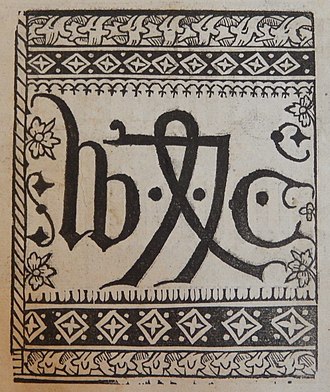

But very soon we became more interested in making traditional
cloth as well as rugs and attempted some overshot weaving. That
did not go well, and we realized we needed some guidance and
assistance more than
we had found in books.
Shortly after the few less succesful trials of weaving
more traditional cloth, Ellen found a nearby master weaver, Bessie Swain, and
began taking lessons from Bessie. Bessie, and her husband, Howard, had been early members of
the League of New Hampshire Arts and Crafts
in the 1930's and she had taught weaving
and other crafts for decades. The lived in a large, rambling, old New Hampshire
home in Exeter filled with looms and other weaving equipment, most of it "saved" by them
as the popularity of weaving waxed and waned through the years and any equipment
in danger of being thrown away could fine a home with them. There were also many looms made
by them and
used to instruct young people in weaving.
In 1938, Bessie had founded
the New Hampshire Weavers, an offshoot of the newly organized League of New Hampshire
Arts and Crafts.
The parent organization, now the League of New
Hamshire Craftsmen, still going strong and operating several galleries in the state. and
the New Hampshire Weaving Guild continues their craft.
We learned a lot about weaving and about life from Bessie. She was an inspiration
and a Yankee through and through. We also got from her the tendency to acquire looms
and other weaving paraphernalia.
Here are some of the overshot patterns woven during that time and later. The first
is an overshot sample Ellen did under Bessie's tutelage. The rest are of various
projects including one of a handbag using a small overshot piece.

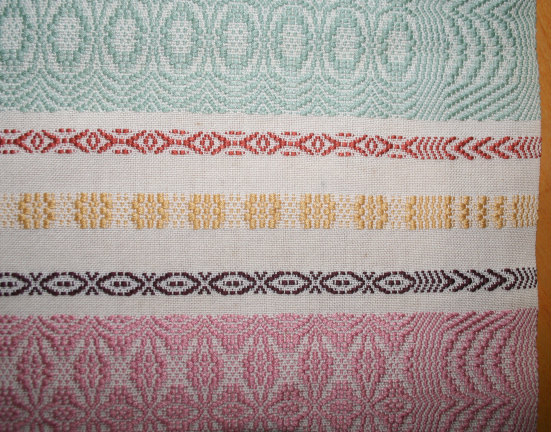

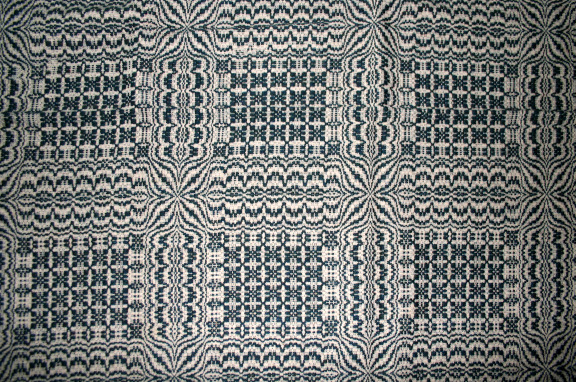

Soon after moving to New Hampshire, we purchased a small flock of sheep. Although
we were intending to convert the farm to orchards, we wanted to use the land in the
meantime for other farming purposes and raising sheep seemed a good idea at the
time. There is more about our adventures and misadventures raising sheep on the
New Hampshire Page.
And with sheep, comes wool, as they needed to be sheared annually. At first we
had a neighbor shear the sheep for us, but soon were doing our own shearing and
raising the lambs to add to the flock. At first we sold the wool, which was
nearly worthless as the international wool market was dominated by the
Australian producers. Wool from Australian sheep was largely from Merino breed
of sheep, and was finer, longer, and had a better crimp for spinning than
American produced wool. The Australians also sold wool through a huge
conglomerate of producers, storing and stockpiling the wool to market it at
the best time and price. And controlling the world price for their product.
Some years later, on a visit to Old Sturbridge Village, Massachusetts, a "living
history" village
and museum recreating New England village life from the 1830s, I picked up a copy
of a reproduction news letter from that era. Among other things, the flyer had the
then current price for wool, fifty cents per pound. Which was the exact same price
we had gotten for our wool through the U. S. Department of Agriculture subsidized
"wool pool". Not much progress in 150 years. It was soon after that we
started selling our wool differently and also
started sending some of the lambs to market each spring.
We found out about Bartlett Yarns, a small spinning mill located in
Harmony, Maine, about a three hour drive from us. At that time, they
did a "trade" arrangement, whereby a local wool producer would give their
fleeces to Bartlett and get a proportion of the fleece weight back as finished
yarn. That seemed a really good deal to us, and we soon ended up with a
supply of Bartlett yarn for knitting. We soon had more than enough yarn for
our projects and began to store the extra and soon were selling
it from our Kitchen.
And thus, Ellen was in the yarn store business and "Andes Yarns" was born.
Bartlett yarns was established in the early 1800s and spun its yarn on
spinning "mules". These spinning machines spun yarn using a technique very
much like that used when spinning by hand on an old fashioned "walking
wheel". The machines in fact closely duplicated the motions used by
a hand-spinner working with such a wheel. The rotating spindles of the
spinning-mule machines first twisted the yarn as they rotated
in a near horizontal axis briefly. Then the entire machine, with its multiple
spindles, moved on a track across the mill floor almost the width of the
building, imparting
both spin and traction to the yarn as it spun. The combination of spinning
or twisting the fibres while pulling on the growing yarn is what "sets" the
spin and interlocks the fibers. The mules moved out to their
full distance away from the head of the machine, which held the roving, the
lengths of carded but unspun wool. Then the
spindles turned vertical and as they rotated the entire machine moved back
across the floor to its
original position, winding the yarns onto the spindles. The process repeated
until the spindles were full and the yarn needed to be removed by the
attendant to continue
the spinning process.
Yard to be spun is first carded into a "roving" in which the
fibers of the wool were oriented mostly in the same direction, a circular
direction around the circumference of the cylinder of the carding machine or
the surface of the hand cards. Carding is a sort of combing using two
fine metal comb-like surfaces moving in opposite directions to orient
the fibers of the wool in mostly the same direction.
When spinning, the wool from this roving was taken from the middle
of the roving, producing a yarn in which the fibers tended to lie more
perpendicular to the length of the yarn rather than more parallel to it.
This type of spinning is termed "woolen" spinning and produces a softer
"loftier" yarn, than yarn spun by the "worsted" spinning method. In worsted
spinning, the yarn is carded to produce a roving in which the fibers
are more aligned to what will be the length of the yarn and the spinning
is done from the end of the roving to maintain that alignment. Worsted
yarns are stronger than woolen spun yarns and have a more polished look
and surface. They also generally are more durable.
Hand spinning on a "sitting" wheel or "flyer wheel" incorporates the
two motions of
twisting the fibres and pulling on them by having two parts of the
spindle assembly that rotate as slightly different speeds. There is a
central bobbin that rotates at a slightly faster speed than an outer
U-shaped "harp" or "flyer". The
roving enters through a hole in the end of
the rotating assembly, which imparts the twist to the
yarn as it feeds through hooks on the harp, then down to the bobbin,
rotating a bit faster, to apply the tension. The wheel has two drive belts,
or more often, one continuous belt which is doubled. One belt turns the
whorl or pulley on the harp, the other the pulley on the bobbin. The
bobbin and harp pulleys are of slightly different diameter, to produce
the slight difference in speed needed to set the yarn. This spinning machine
eliminatesa the spindle.
Spinning on a sitting wheel, a hand spinner can produce either
"wool spun" yarn, the softer, lofty yarn in which the fibers are
oriented around the axis of the yarn, or "worsted spun" yarn, the
sleeker, stronger yarn in which fibres are oriented along the axis
of the yarn. The spinner will alter the product by changing
how the wool fibers are pulled from the roving and by either pushing
or pulling them as they enter the spinning wheel.
And yes, as the years passed, Ellen expanded her yarn business to
include not only knitting yarns, but yarns for weaving. And looms and
other weaving equipment. And spinning wheels.
Andes Yarns
The yarn business expanded with our interest in the fiber arts. Ellen
dealt mostly in natural fibers and did a lot with wool, from dying
wool using plants growing on the farm and along the roads, to spinning,
through weaving and knitting. We never returned to doing much Macrame
during those years, except when Dale Schwichtenberg came to study and
stay with us, through a connection with our friend, Mike Price.
There is more information on Andes Yarns and the farm life on
the New Hampshire Page
Ellen's shop carried a wide array of equipment and supplies. She
had spinning wheels from Ashford, Wee Peggy, and Clemes. Looms and
accessories from Schacht and Harrisville Designs. And yarns for knitting
and weaving.
Following are pictures of a small sampling of the many woven projects
done during that time. We also collaborated with a weaver friend,
Penelope Drooker, who
lived nearby, in writing two booklets of weaving patterns which
are shown on the Publications Page.
Scarves were always a good way to try out new yarns and experiment with
patterns. There were multiple table looms set up in the yarn shop with
four to eight harnesses to use for experimenting, for teaching students, and
for sale.
Here are a few of the many scarves.
There were many twill variations, as above, and also some scarves
using other traditional weaves, such as Huck, waffle weave, and
ornamental touches such as the twisted warp border shown below.
And Ponchos, capes, tunics. These were also great ways to experiment
with new yarns and combinations of different fibers. The first example
is a tunic with matching hat and mittens.
Ponchos were also a simple way to use flat woven pieces
of fabric. Here's one example using an ornamental "slub"
yarn with a detail picture of the piece to show the texture.
Below that is a photo of another piece done in "shadow
weave", which gives a subtler texture and pattern.
We also wove plenty of fabric yardage. Here's one example, a
plaid woven in fine cotton, which we used to make up an apron (shown)
with matching place mats (not shown), napkins (shown), and coasters
(shown). Just the thing for the co-ordinated host or hostess to use
for a nice luncheon. Martha Stewart, eat your heart out.
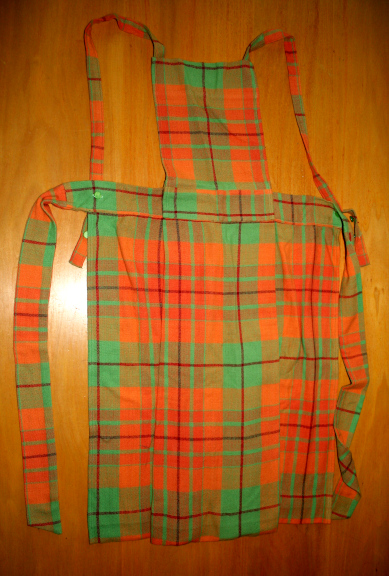
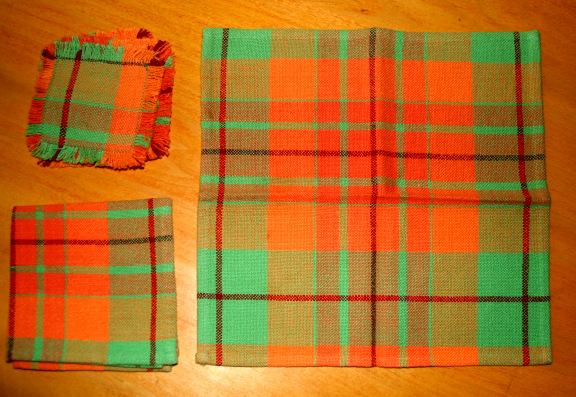
We also explored traditional tartan patterns and modified them
to use for projects and especiall for yardage to make into
clothing. Here's a picture of a modified tartan pattern
woven with Harrisville Designs single ply yarn and made into a skirt
and cape. The skirt is shown and below it,
are two pictures from the Weave and Wear It series. On the left
is the back cover and shows this skirt with its matching cape
modeled by one of the women working in the Harrisville
Designs office. This picture also shows a tunic top woven in
the same yarn on the right and a Berber-style cloak by Penelope Drooker,
also in wool, in the center. The cover of that booklet is on the right
below and shows
more cloaks, ponchos, and tunics from the instructions. Also modeled by
the Harrisville Designs office staff.
Here's a woven coat in wool, lined with sateen, and combined with a
knitted scarf from one of the yarns used in the coat.
And finally, a few pictures of the yards and yards of fabric
we wove. Yardage that is still waiting for use. It is a big job
to set up a loom and thread all the warp threads through the heddles,
so we rarely made a warp of less than six yards length, and usually
much more. So we ended up with plenty of remainder fabric, even
when a project was done.
The first shows a simple twill weave in blue and white and is
a nice illustration of the softness and texture that "fulling"
woolen cloth gives.
And another example of the modified tartan patterns we made in
Harrisville single ply yarn. This fabric is 100% wool and the piece
is about 40 inches wide and six yards long.
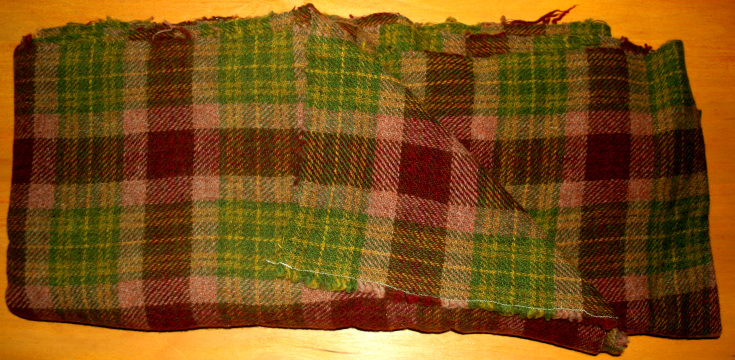

All these photos might represent about five percent of the weaving
output during the lifetime of Andes Yarns. By the time we closed
it to move overseas for a few years, it occupied about 1200 square
feet in our barn and was full of looms, wheels, equipment and supplies.
And plenty of yarn!.
In another example of the connections and coincidences in life, sometime
around 1980 I met and worked for a time with Rolf Lium, a retired
general surgeon. When our conversations turned to avocations, I
discovered that his hobby was making Rya rugs. He made copies of
famous impressionist and post-impressionist paintings into rugs
4 to 6 feet wide and 6 to 10 feet long by stitching wool yarn onto
a fabric backing, using the row spacing and pile length of the traditional
method of making these rugs. His work was astounding and beautiful.
By that time, we were no longer making pile rugs, so it was a meeting
that was about ten years too late.
When we closed down the yarn shop in 1986, Ellen sold off most of the
inventory of equipment and yarns, but kept an eight harness Schacht floor loom,
an eight harness Schacht Baby Wolf folding loom, and several table looms.
And a spinning wheel. And lots of yarn. But when we moved to Oklahoma in
1994, there was little going on in the weaving/spinning area. In that
part of the country, quilting was probably the most popular of the fiber
arts.
The looms and sundries moved with us to Virginia, then California, but
in both those places, there wasn't much weaving going on. Ellen got
seriously into needle work in Virginia and continued that in California,
but gradually did less and less weaving. She sold the large Schacht loom
in Arkansas, the Baby Wolf in Santa Fe, and found a home for the Louet wheel
and the last of the table looms with a friend in Santa Fe, who took
them back to North Carolina to her home there.
Here are a couple pictures of some of the last weaving projects. These
are small pieces done on the table loom. One is a sampler of various twill
and overshot patterns. The other is a complex eight harness weaving of
multiple Santas. The extra Santas from this project became sachets for
hanging on the Christmas tree.

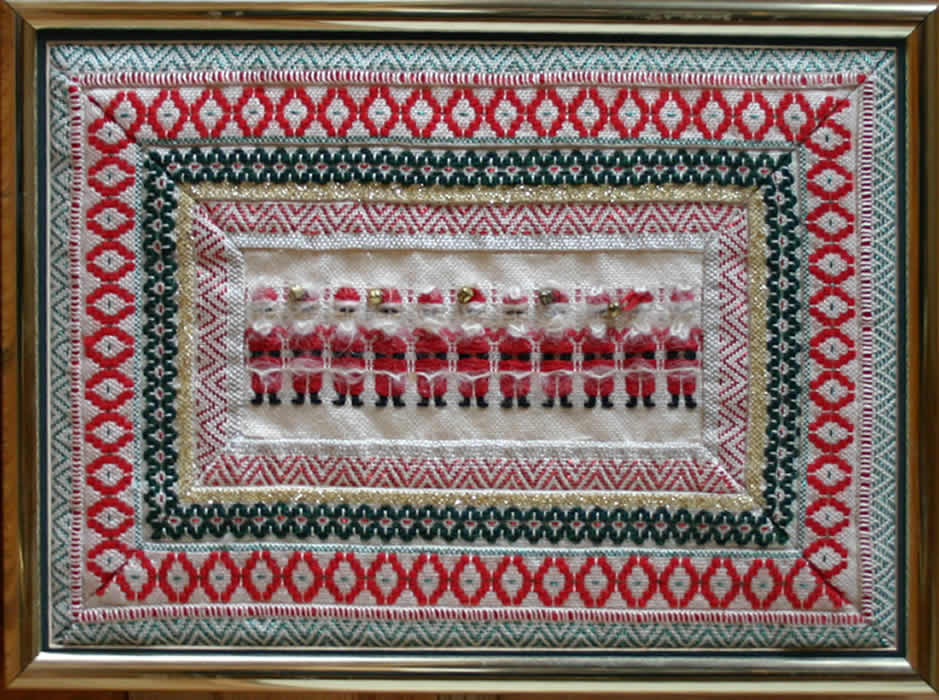
Weaving is a very interesting craft, which requires the practitioner
to master the loom and the complex topic of pattern drafting and
design. Since making cloth is such a basic part of civilization and
since it has been done commercially for centuries, the amount of
knowledge and experience available is huge and can't be mastered in
a lifetime. But it is a wonderful pool in which to swim. Or even
just a short dip. And the range of available materials to use in
weaving is equally vast.
But weaving has a couple of drawbacks, which eventually had us moving
on to other crafts. First, weaving is physically demanding work. Setting
up a loom requires great agility as well as a great deal of time.
Second, the larger issue is that weaving, for the most part, is not
portable. There are small table looms that one can carry about, but
the really fun and satisfying work is done on a floor loom. And most of
the floor looms we used needed two people to move them around. Last,
weaving requires lots of time and study and preparation before the first
weft thread shoots across the warp shed. You can't just dabble in weaving.
It requires committment of time and attention. And as we became more and
more portable through successive down-sizes, weaving was supplanted by
knitting and needle work. But we miss the weaving.


